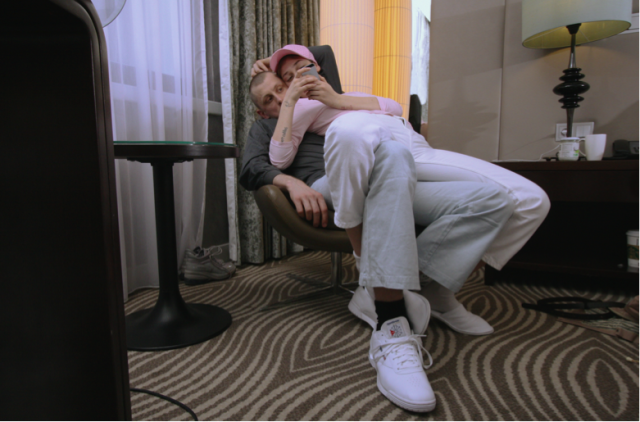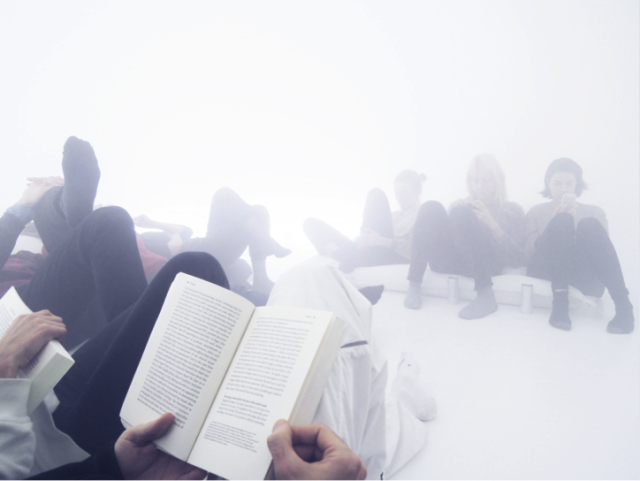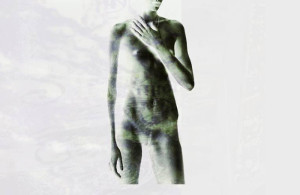Recently, a series of shared links led me to the activities of Young Girl Reading Group (YGRG), a weekly event organised around feminist inspired theory and fiction, and an interest in technology-driven emancipation. The project began sometime in 2013 after artist-collaboration Dorota Gaweda and Egle Kulbokaite read the semiotext(e)-published English translation of Tiqqun’s French language Preliminary Materials for a Theory of a Young-Girl. As a book examining the compulsion to consume under capitalism in relation to sexual behaviour, gender, youth and beauty, Gaweda and Kulbokaite were intrigued enough to create a discursive space problematising the network’s open-circuit, defined by a meeting that occurs every Sunday at 7pm, without fail.
In an era when internet-based imagery increasingly represents and brands our understanding of digital inspired art production and cultural intervention, YGRG renewed emphasis on text and theory ‘overload’ offers a potential development in art. This next critical wave returns to text, theory, live reading and new forms of performativity carried out by individuals, collectives, online and IRL to achieve this.
Examples of YGRG’s textual fluidity can be found in locations like Berlin Community Radio, Import Projects, Oracle, Facebook or via Skype. Or in non-branded situations like people’s home, artist studios or public spaces casually occupied.
This year has been particularly productive for the artist collaboration, sometimes referred to as YGRG, but also defaulting to Gaweda and Kulbokaite’s actual names or via other artist collaborations, like d3signbur3au with Catherine Prieto Österberg, collaborating to produce another form of agency, via the post-gender avatar, Agatha Valkyrie Ice.
Museum of Post Digital Cultures, Switzerland-based online platform invited YGRG to realise a curatorial project in relation to the group’s reading and archive. In She wanders through the cities of deserted islands, YGRG address how internet-based art is exhibited and collected. It reflects, of course, the growing number of artists who engage with the online as a standard, rather than an exception. Other projects that have recently supported YGRG’s experimental activities are the exhibition in two parts Agatha 1.2.0.1 at Center project space and the Hilton Hotel in Berlin, produced by Gaweda, Kulbokaite and Clémence de la Tour du Pin and the two year programme for OSLO1O (run under Agatha Valkyrie Ice together with Ana Andra, Zayne Armstrong, Dorota Gaweda, Elin Gonzalez, Egle Kulbokaite and Aaron Ritschard). Agatha Valkyrie Ice, who adopts the pronoun ‘Ai’, is the focus of the former’s invitation with Ai effectively curating the programme between 2015 to 2017. No doubt, the approach will be a test in avatar-led curation, perhaps even the first to be sustained over such a long period.
Many interesting questions about the socio-political effects and cultural and aesthetic influences of the internet are raised in YGRG’s many actions. Backed-up by a long-term engagement with theories that also take the ‘post-’ prefix as its signification, one question that standsout is: after the appearance of so-called ‘Post-Internet Art’, can there be a return to ‘pre post-internet states’? Much like a running river, the assumption is that its influence becomes harder to reverse. Related to the proposition of dematerialising art or art orientated around events, as seen in Conceptualism and Performance Art, the aesthetic peer-to-peer effects of art and the internet are still to be felt and understood. YGRG’s art offers one direction to follow.
By way of introducing YGRG, the project takes a typically extravagant approach to reflecting on its recent activities via a manifesto of sorts; a hyperlink-heavy selection of quotes, references, aphorisms and assertions, which at times read like concrete poetry, at others, a comment feed on social media.
Taking three months to complete, what began as a simple in-person interview request became emailed questions answered and performed in responses appearing simultaneously, and word-for-word, in other online forums, maximising YGRG’s manifesto-like public utterances. Perhaps what follows can be best described as a kind of data collection with the interview format as its convenient proxy.

The Preliminaries
Young Girl, I did love you once.
-Hamlet
Young Girl Reading Group – I thought that was for girls only?
-Anon
i
Let’s be clear: the concept of the Young-Girl is obviously not a gendered concept. The nightclub-going jock conforms to it just as much as the second-generation North African girl painted up to look pornstar old. The spirited telecom retiree that splits his leisure time between the Cote d’Azur and the Parisian offices where he’s kept a foot in the door, and the metropolitan single too caught up in her career in consulting to realize that she’s already lost fifteen years of her life to it—both obey the concept.
Tiqqun’s Preliminary Materials for a Theory of the Young-Girl shares a rhetorical strategy with texts that have been far more widely diffused and discussed, opening with a 10-page excursus sketching the total war that contemporary capitalism wages against anyone who dares oppose it.
Stylistically, Tiqqun operate in the speculative void-space created by situationist-style and Agambenian portentousness—detournement meets poetic ontologizing. The style is assertoric, even where the claims made are highly evaluative. Hundreds of sentences begin ‘The Young-Girl is…’ This grinding repetition is ameliorated only slightly by the use of varied font styles and the insertion of quotations not only from women’s magazines, but also from Baudrillard, Witold Gombrowicz’s 1937 novel Ferdydurke, spiritual instruction manuals and texts on eating disorders.
Tiqqun’s quips about tampons and Young-Girls’ body parts, which they insist are “not gendered,” resemble the cringe-inducing song about seeing actresses’ “boobs” that Seth MacFarlane wrote for the Oscars and Daniel Tosh’s much-discussed off-the-cuff rape joke (:/). In each case, a speaker insists that he is not saying what he says, employing the verbal irony to conceal the misogyny that they actually communicate. Here Tiqqun steps into an old-fashioned patriarchal role.
ii
In reality, the Young-Girl is only the model citizen, the highest point of alienated socialization, where the most socialized is also the most social and she suffers. She suffers from alienation as much as a she does from becoming-image of this alienation. As such, she is a polar figure, representing becoming-Young-Girl more than predominating it. And she suffers from this misogynist identification. What, ultimately, would it mean to let the Young-Girl speak for herself and not through the categories imposed upon her by a culture that heralds her as the metaphysical apex of civilization while simultaneously denigrating her?
Behind every Young-Girl’s arse hides a bunch of rich white men: the task is surely not, then, to destroy the Young-Girl, but to destroy the system that makes her, and makes her so unhappy, whoever she is. Thus, the image of the Young-Girl gives the name to our project and opens up to the problematic networks of ideas to be discussed. This very uneasy relation what we feel towards the Young-Girl triggers the need to commit to YGRG as a space for conversation that develops in a defined moment in time dedicated to examining together the text in question. It names reason as an engine of feminist emancipation, and declares the right of everyone to speak as no one in particular. The Young-Girl here is the one who’s acting:
Let us say SHE for all being, that is, for everything, every time in her essential plural—language speaking for all and of all, in her name, including those who may not have a name … the one through whom she comes to be and happen, which does not speak but is never the less stone fish fiber dough crack block breath. Language says the world; that is, it loses itself in it and exposes how in herselves it is a question of losing herselves in order to be of SHE, that is, to be her meaning, which is all meaning. SHE is ready.
The question has always been of deciding how to position sheselfs within manmade theory, built on truth with its too often thinly veiled misogynistic (under)tones, prejudices, oversights and omissions. We are looking for discourses, or readings aiming towards a visibility of underrepresented positions where the Other gains an agency. We are drawn towards feminist writings both historical and contemporary.We are interested in the interrelationships between gender and technology, in particular, the intersections of technology, power, gender and desire.
Will technological progress determinately destroy institutions of thought on its own, or will political organization need to take over technology beforehand? Can we trust that the inner development of technology will unfold in the “correct” way? Or that technophiliac revolutionaries, for that matter, will seize control of the means of scientific production and immediately redirect its possibilities in a revolutionary way, in Firestone’s mind, to clear the way for the liberation through technology of the link between human biology and human destiny?
iii
Her glands expand. Her mouth waters. So hot rn. Young-Girl reads for everyone with everyone.

The Phenomenon
It starts with the name. YGRG as abbreviation is in itself an aesthetic choice.
Then follows the form and distribution. YGRG functions casually on Facebook, where the digital YGRGs weave new networks from what had once been isolated words, numbers, music, shapes, tactile textures and architectures. The individuated texts we choose become filaments of infinitely tangled webs.
YGRG addresses the mutations within the figure of the Young-Girl that follows symmetrically the evolutions of the capitalist mode of production. Over the past thirty years little by little we’ve moved from a Fordist type seduction, with its designated places and moments, its static and proto-bourgeois couple-form, to a postfordist type seduction, diffuse, flexible, precarious and de-ritualized, which has extended the couples-factory over the whole of the body and all social space-time. At this particularly advanced stage of Total Mobilization, everyone is called upon to keep up their “seduction power,” which has replaced their “labor power,” so that they can at any instant be fired and set out again on the sexual market. YGRG aesthetic explores this shiny surface.
The dissemination of art online is now an unequivocal fact, while Facebook becomes a platform for attending as many art openings as there are. This competitive field of online participation acquires its own a science of craft, rules, predictability, theft and imagination. We are all bot-poets. Our identities are somewhat interchangeable, ratifiable.
While Tiqqun focuses on women’s magazines, it is easy to expand their analysis to encompass developments in social media that have taken place since the book’s original publication: the direct facial and self-valorizing imperatives of Facebook, the endless memetic re-postings of tumblr, fashion blogs, and so on. But what does this domination of the Spectacle really mean?
The Web has become a mirror for the ego of an absent but very present author. Reposting we render self in a pseudo-post-binary world. We wish. lol
The self, converted to the selfie.

2
The Technique of the Self
“In truth, Freud sees nothing and understands nothing.”
– Deleuze
She is the middle.
With the exhibition She wanders through the cities of deserted islands at Museum of Post Digital Cultures [where?] we are searching for a visibility of underrepresented and marginalized positions, attempting at presenting new possibilities for digital cartographies, aided by the museum’s Google Earth inspired format. The infrastructure of the website facilitates the creation of non-linear narrativity, where links create networks opening up to a multitude of pragmatic possibilities of their use, which enables us to create a fictionalized YGRG archive. Only when digital networks arrange themselves in threads and links, footnotes begin to walk all over what we once saw as the bodies of organized texts. Hypertext programs and the Net are webs of footnotes without central points, organizing principles, hierarchies.
Aiming towards the becoming-visible, becoming-prominent, we adopt a she as a main character. We have been consistently developing this she in a series of texts called for a future (2013-).
her name is agatha or valkyrie ice. she speaks her ideas to her others in color, music, gesture and specially made concoctions of the liquids still unknown. She cannot, does not want, and is ready for everything
She wants superior forms of corruption.
She wanders through the cities of deserted islands. She drifts through the exhibition in the Museum of Post Digital Cultures that unfolds over the consecutive Sundays in May and June—following the original YGRG format and expanding on the YGRG archive with non-linear fictionalized narratives, constructed through background artwork, text, image and link constellations. Taking as a point of departure our immediate environment, we construct a story that can be read from any one point leading to any other. One finds within the story no end and no beginning, only middle, lines of flight; she brings us closer to the de-territorialization of our own subjectivity.
She wanders through the cities of deserted islands and reads through selected chapters of:
Simians, Cyborgs, and Women by Donna Haraway
Caliban and the Witch by Silvia Federici
Flesh & Stone by Richard Sennet
The Dialectic of Sex by Shulamith Firestone
Testo Junkie by Paul B. Preciado
—texts that we find particularly relevant after two years of YGRG meetings.
She is a portrait of an immortal androgyny, she lies formless in the middle, unlike a tree or their roots. She connects any point to any other point, and her traits are not necessarily linked to traits of the same nature; she brings into play very different regimes of signs, and even nonsign states. She is the fluctuating center.
She is there where we end and where we begin, on the limits of the cities of deserted islands, becoming a denominator both within our texts and, as we hope, within language.

3
The Social Relationship
We started the Agatha Valkyrie Ice project by creating and developing a fictional post gender character, ‘Agatha’, within an existing confined framework of social media: facebook, soundcloud, snapchat, tumblr, tinder, 3nder, grindr, etc. Going through each of the existing categorizations including age, picture, gender, date of birth, body features, weight, diet, hobbies, interests, family status, height, sexual preferences etc..
We attempted to insert Ai within established systems and observed and analyzed the clashes and controversies this move created. Ai is our consideration of what a post gender person can be today — totally generic and post-sincere, shameless in mixing different stereotypes of individuality to the point where there’s a new confidence in being unoriginal.
Agatha still lives in profiles that currently open up as sites for all forms of expression. Agatha exists in parallel to the realities of YouTube clips of cats, of playing guitar or dancing, dogs dressed as humans, Sunday hobbyist instructional videos, Museum of Internet and eBay wish lists (called ‘my swag’.) Agatha has become a companion species, here to think with and to invent a body and a sexuality of one’s own. Agatha is immersed in a constant process of becoming; a loop of re-posting, re-staging and re-appropriating expressed in textual form, on social media as well as IRL.
Through a multiplicity of voices Agatha is articulated in the world of materials as moments of performance, installation, sculpture or constellation of scents, as was the case for instance in Agatha 1.2.0.1 (in collaboration with Clemence de la Tour du Pin). Agatha is being transformed into a materialized agency through actions that involve inserting Ai into positions of responsibility as the director of OSLO1O . We see that we live in a world surrounded by multiple types of becomings of which we are an integral and fluid part. We see Agatha as a possibility to #buildyourown#body, to achieve various forms of becoming, such as becoming-woman, becoming-animal, becoming-molecular, and becoming-imperceptible.**















